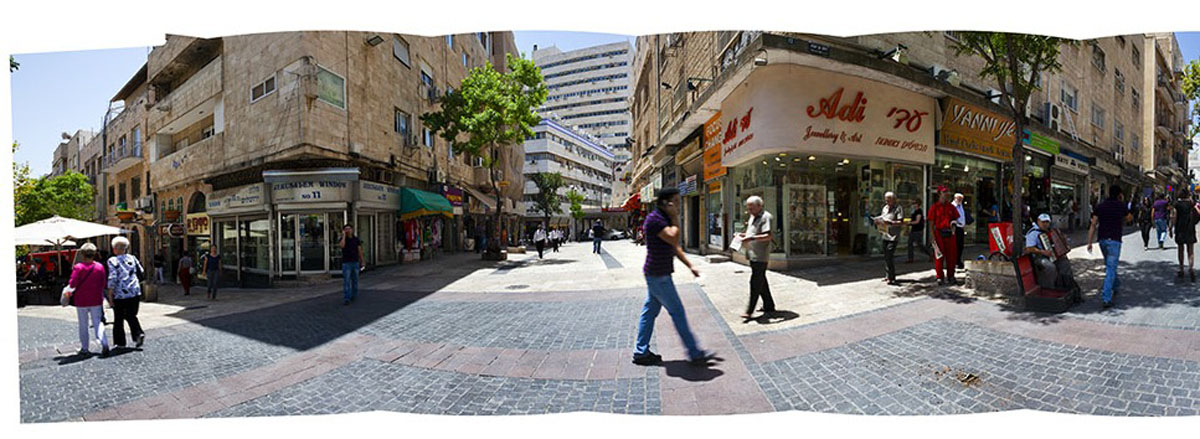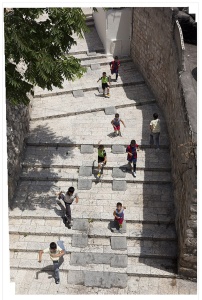Forever Young, Forever Old: Panoramas of Israel
Photographs seems like cruel little slices from the past, frozen images of what will never be again. Since we assume that the photographic image is, by and large, a factual view of some reality, it is inherently believed and trusted. But now be forewarned. It ain’t necessarily so. Bill Aron’s new images at the 92nd Street Y betray and beguile so as to force us to reassess the meaning of what we see.
The passage through time is a core human experience, not to mention a fundamental Jewish structure. Halacha is deeply time bound, changing every seven days to reflect Shabbos and cycling through the year to encounter holidays, memorials and reflections that make up the fabric of Jewish life. Each day time demands different actions or restraints on Jewish life; when to pray, when to work or not, when to laugh and when to cry unfold in a constant flow of future, present and past. How this continuum encounters photography is the subject of Bill Aron’s current fascinating exhibition.

The majority of Aron’s photographs here are “multi-image panoramas.” They are created by taking multiple digital exposures, sometimes scanning a scene up to 360 degrees and at times revisited over several days, and then seamlessly stitching them together to create what at first seems like one unified image. He invented this technique in a thoughtful response to the challenge of contemporary digital photography. Western Wall Plaza at Night is an excellent introduction to this methodology.
The 9 ¾” by 40” wide photograph cannot be realistically seen in one glimpse. To do that one must stand back a few feet and thereby much detail becomes indiscernible. As you get closer it becomes necessary to scan back and forth to accommodate the photo’s width. Even that is not totally satisfactory and so walking along the image becomes the ideal way to take it all in, thereby forcing the viewer to mimic how an actual viewer of the scene would have to shift focus and position to take in the panorama. But it is in the very content of the image that time begins to flow.
The ancient Western Wall itself becomes the timeless pivot through which the dusk into night scene seems to evolve, passing from the glowing pink of sunset on the left to the rich darks of night on the right of the image. Significantly the dark sky is punctuated by a burst of fireworks that emphasize the complete arrival of nighttime. In this one image we have traveled through a halachically crucial time; what is called “Bein Hashmashis.” It turns out that this image is not about a specific past event, but thanks to the “eternal” nature of this architecture, i.e. the Western Wall, is about a perpetually recurring event, the interlude between day and night in Jewish practice.
Aron’s most intriguing images involve the dialogue between static architecture and people passing through a scene who by their multiple images, once we notice them, invoke the passage of time. Crucial to his methodology is the viewer’s tendency to view an image casually at first and to see repetition in a photograph as normative and not significant. With Bill Aron’s work that is a big mistake.

Western Wall Plaza During the Day initially looks like a ragged-edged panoramic snapshot. Upon closer examination of the 10” x 40” image, (with all its complications described above) we notice a kind of visual echo reverberating through the image. Looking closely we see repetitions; three figures in red reappear approaching the Wall, first from afar and then closer and closer. Other random individuals reappear in other unexpected repeated positions. Perhaps these are simply individuals in a tour group dressed alike or yeshiva boys and frum girls, all dressed in a kind of uniform. But looking carefully these figures are too much alike. In fact in almost all cases, it is the same person at different locations literally advancing through time. The viewer slowly understands that this image is manipulated to drag us through time moving forward. This image transcends stop-time photography because the visual context overwhelmingly tries to convince us that it is but a momentary snapshot. It is not; neither internally in its own image nor when seen juxtaposed with Western Wall Plaza at Night, a nearly identical composition and perspective. They are both grounded in the eternal Temple Mount but radically separated by night and day depicting time’s passage itself.
The catalogue essay by the photographer considers two philosophical approaches to time. “Presentists” believe that future, present and past are always operative and distinct aspects of time, only the present being actually “real.” The “Eternalists” grant equality to all aspects of time; equally “real” and simultaneous. For them time has no future, present and past, only a unity. This Eternalist approach echoes the assertions that Israel and Jerusalem are eternal, a deeply Jewish point of view that Aron wants to express in these photographs.


For many secular Jerusalemites Ben Yehuda Street is the heart of their city. Aron’s multifaceted image of the intersection of Mordechai ben Hillel and Ben Yehuda appears at first as a sparsely traversed urban center with scattered people going about their normal everyday business. But then little shocks of repetition jolt our consciousness. That lady in the cream-colored top and blond wig suddenly seems to be following herself, as does the fellow in a white shirt, suspenders and black pants emerging way down another street. Once I see him it is almost normal to see the guy talking on the cellphone flitting across the photograph and turning the corner down another street. The whole somewhat unsettling experience has broadened my perception of Ben Yehuda Street. Beyond “seeing” this intersection as a unity, physically impossible in “real life,” I now notice that time has been simultaneously expanded and contracted. The slice of time is much longer than an instant because I can see some of the people at various stages of their journey on that sunny day. Contradicting that is the odd fact that the shadows seem to be facing arbitrary directions, also impossible in this wide-angle view. Time, here defined by the sun, has been confused and condensed.

In a totally different way Aron plays with time within the image itself and within the continuum of his own work. Tallit Steps (1999) is a black and white image of a small street or passageway seen from above. It has ramped sections broken by a series of 2 or 3 short steps as it winds down an incline. In the bright Jerusalem sun it is reminiscent of the stripes on a tallis. In 2010 he created Tallit Steps Revisited with a slightly altered perspective in color. Before only two children rested on the steps, now 9 boisterous kids appear to scamper down the steps. Of course we are learning to look closely and realize that only five boys are actually “present;” four of whom play multiple visual roles and playfully warp time so much so that one of the boys actually looks up and fixes our gaze, beaming him into our present.
The photographer makes similar forays seeking to document time’s simultaneous and expansive nature by exploring the Inside Aish HaTorah Yeshiva, where through the learning, time collapses, Men at the Western Wall, where an age old practice is enacted, Women at the Western Wall, that expands the time-bound obligation of prayer, and the Yaffa Gate Entrance to the Old City. In each of these very wide and narrow photographs the juxtaposition of static, timeless architecture or interiors is in tension with the multiplicity of human life existing through time along with its implications that such human activity will continue far into the future, a future implied by the depth of time represented.

Memorial to the Helicopter Crash in the North near Kiryat Shmoneh distinguishes itself from the scale and tone of the previous works discussed. Here the figures walking around the reflecting pool memorial predominate the image. A memorial by its very nature looks back on a tragic event, so here the sensibility of the image is focused on the process of mourning and reflection, literally expressed in the water’s reflection of the individuals present. We visually walk around with the pair of religious girls starting at the right. One is in a light blue top and the other sports a black and white stripe blouse and we see them twice. Further along a young woman with a bulky red jacket and a tan dog appears four times across the center of the image. Finally a woman in a floppy blue hat and sneakers slowly advances toward us in three iterations. This basic rhythm is reinforced by other individuals who move behind the main actors, especially a fellow in cut-off jeans and white sweatshirt who appears no less than five times further weaving the motion left to right around the pool. This is possibly Aron’s most complex and pensive image in which time is resolutely kept in a meditative past.
Bill Aron’s photographs have been seen in these pages before, specifically a book and exhibition, Shalom Y’All (June 2004) [on Southern Jewish Communities] and Holocaust Survivors: The Indestructible Spirit (November, 2007). This current exhibition, which by the way must be seen up close and personal, seems to fundamentally change the rules and forces us to reassess not only the subject matter he presents, but also the very act of seeing. The lesson here is that photographs are not facts and cannot be inherently trusted as such. Rather they are visual essays of ideas and concepts that need to be carefully and analytically approached. To do so will yield rich rewards for his work and many others, time and time again.
Bill Aron’s Time Machines
Forever Young, Forever Old: Panoramas of Israel
92nd Street Y: Milton J. Weill Art Gallery
1395 Lexington Avenue at 92ned Street